2019 Hyundai Kona wheel
[x] Cancel search: wheelPage 456 of 526
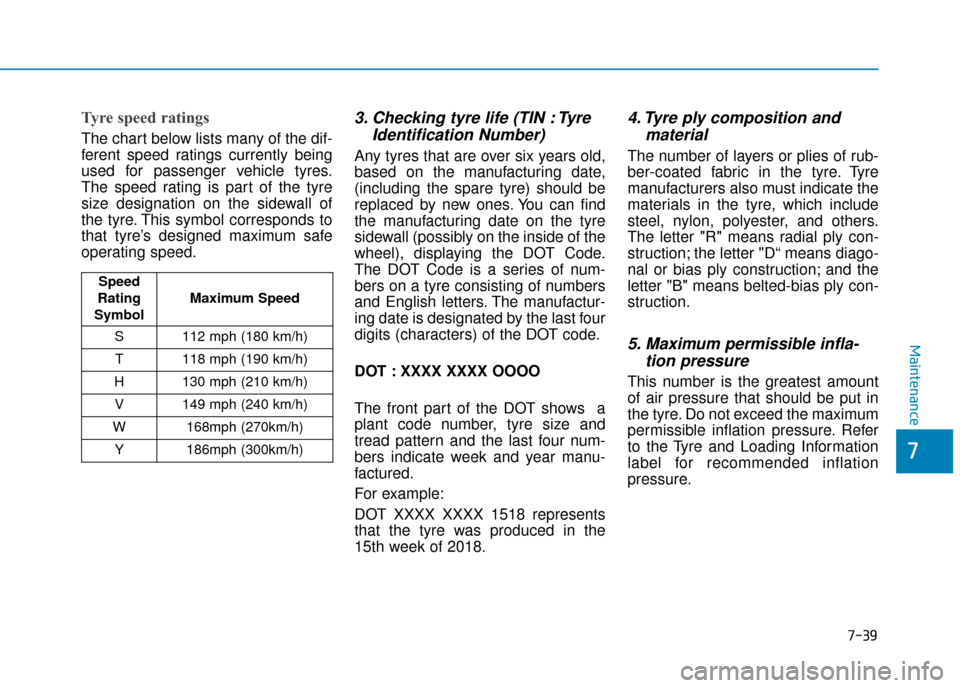
7-39
7
Maintenance
Tyre speed ratings
The chart below lists many of the dif-
ferent speed ratings currently being
used for passenger vehicle tyres.
The speed rating is part of the tyre
size designation on the sidewall of
the tyre. This symbol corresponds to
that tyre’s designed maximum safe
operating speed.
3. Checking tyre life (TIN : TyreIdentification Number)
Any tyres that are over six years old,
based on the manufacturing date,
(including the spare tyre) should be
replaced by new ones. You can find
the manufacturing date on the tyre
sidewall (possibly on the inside of the
wheel), displaying the DOT Code.
The DOT Code is a series of num-
bers on a tyre consisting of numbers
and English letters. The manufactur-
ing date is designated by the last four
digits (characters) of the DOT code.
DOT : XXXX XXXX OOOO
The front part of the DOT shows a
plant code number, tyre size and
tread pattern and the last four num-
bers indicate week and year manu-
factured.
For example:
DOT XXXX XXXX 1518 represents
that the tyre was produced in the
15th week of 2018.
4. Tyre ply composition andmaterial
The number of layers or plies of rub-
ber-coated fabric in the tyre. Tyre
manufacturers also must indicate the
materials in the tyre, which include
steel, nylon, polyester, and others.
The letter "R" means radial ply con-
struction; the letter "D“ means diago-
nal or bias ply construction; and the
letter "B" means belted-bias ply con-
struction.
5. Maximum permissible infla-tion pressure
This number is the greatest amount
of air pressure that should be put in
the tyre. Do not exceed the maximum
permissible inflation pressure. Refer
to the Tyre and Loading Information
label for recommended inflation
pressure.
Speed
Rating
Symbol Maximum Speed
S 112 mph (180 km/h) T 118 mph (190 km/h)
H 130 mph (210 km/h) V 149 mph (240 km/h)
W 168mph (270km/h) Y 186mph (300km/h)
Page 458 of 526
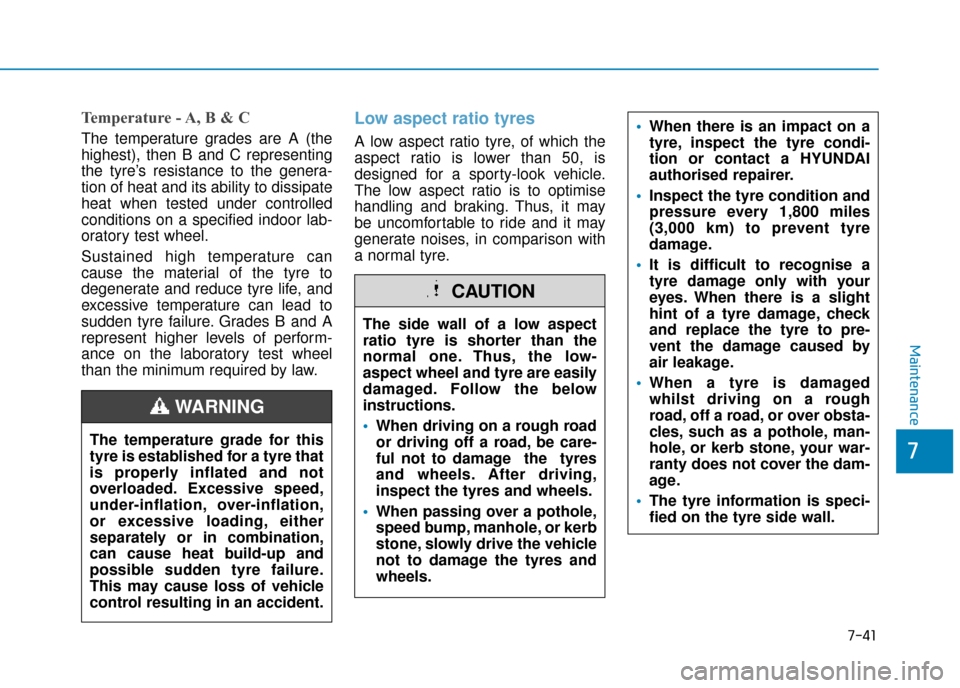
7-41
7
Maintenance
Temperature - A, B & C
The temperature grades are A (the
highest), then B and C representing
the tyre’s resistance to the genera-
tion of heat and its ability to dissipate
heat when tested under controlled
conditions on a specified indoor lab-
oratory test wheel.
Sustained high temperature can
cause the material of the tyre to
degenerate and reduce tyre life, and
excessive temperature can lead to
sudden tyre failure. Grades B and A
represent higher levels of perform-
ance on the laboratory test wheel
than the minimum required by law.
Low aspect ratio tyres
A low aspect ratio tyre, of which the
aspect ratio is lower than 50, is
designed for a sporty-look vehicle.
The low aspect ratio is to optimise
handling and braking. Thus, it may
be uncomfortable to ride and it may
generate noises, in comparison with
a normal tyre.
When there is an impact on a
tyre, inspect the tyre condi-
tion or contact a HYUNDAI
authorised repairer.
Inspect the tyre condition and
pressure every 1,800 miles
(3,000 km) to prevent tyre
damage.
It is difficult to recognise a
tyre damage only with your
eyes. When there is a slight
hint of a tyre damage, check
and replace the tyre to pre-
vent the damage caused by
air leakage.
When a tyre is damaged
whilst driving on a rough
road, off a road, or over obsta-
cles, such as a pothole, man-
hole, or kerb stone, your war-
ranty does not cover the dam-
age.
The tyre information is speci-
fied on the tyre side wall.
The temperature grade for this
tyre is established for a tyre that
is properly inflated and not
overloaded. Excessive speed,
under-inflation, over-inflation,
or excessive loading, either
separately or in combination,
can cause heat build-up and
possible sudden tyre failure.
This may cause loss of vehicle
control resulting in an accident.
WARNING
The side wall of a low aspect
ratio tyre is shorter than the
normal one. Thus, the low-
aspect wheel and tyre are easily
damaged. Follow the below
instructions.
When driving on a rough road
or driving off a road, be care-
ful not to damage the tyres
and wheels. After driving,
inspect the tyres and wheels.
When passing over a pothole,
speed bump, manhole, or kerb
stone, slowly drive the vehicle
not to damage the tyres and
wheels.
CAUTION
Page 492 of 526
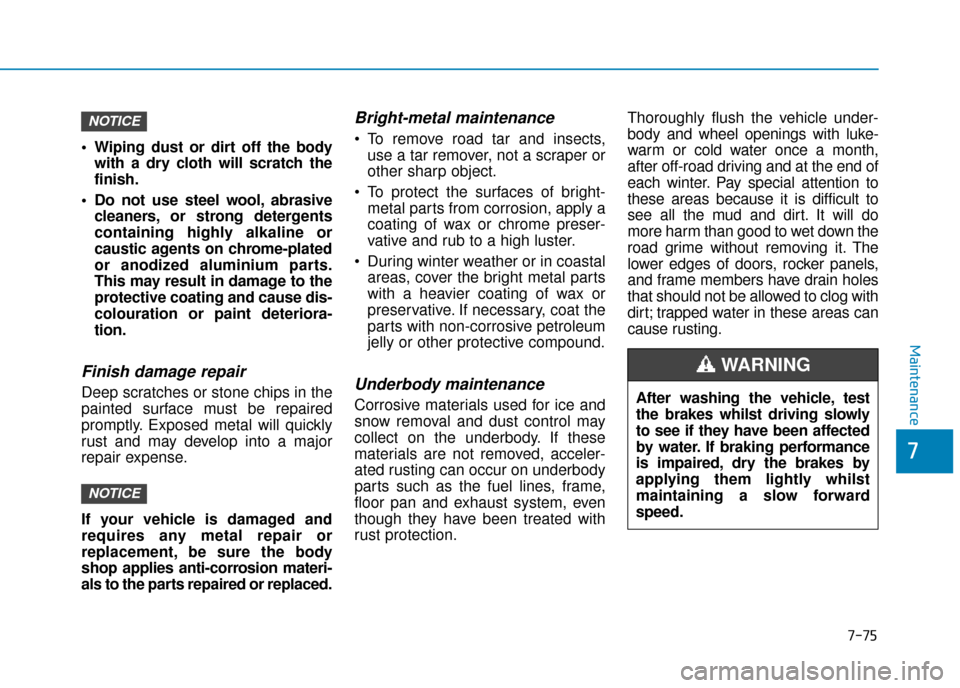
7-75
7
Maintenance
Wiping dust or dirt off the bodywith a dry cloth will scratch the
finish.
Do not use steel wool, abrasive cleaners, or strong detergents
containing highly alkaline or
caustic agents on chrome-plated
or anodized aluminium parts.
This may result in damage to the
protective coating and cause dis-
colouration or paint deteriora-
tion.
Finish damage repair
Deep scratches or stone chips in the
painted surface must be repaired
promptly. Exposed metal will quickly
rust and may develop into a major
repair expense.
If your vehicle is damaged and
requires any metal repair or
replacement, be sure the body
shop applies anti-corrosion materi-
als to the parts repaired or replaced.
Bright-metal maintenance
To remove road tar and insects,use a tar remover, not a scraper or
other sharp object.
To protect the surfaces of bright- metal parts from corrosion, apply a
coating of wax or chrome preser-
vative and rub to a high luster.
During winter weather or in coastal areas, cover the bright metal parts
with a heavier coating of wax or
preservative. If necessary, coat the
parts with non-corrosive petroleum
jelly or other protective compound.
Underbody maintenance
Corrosive materials used for ice and
snow removal and dust control may
collect on the underbody. If these
materials are not removed, acceler-
ated rusting can occur on underbody
parts such as the fuel lines, frame,
floor pan and exhaust system, even
though they have been treated with
rust protection. Thoroughly flush the vehicle under-
body and wheel openings with luke-
warm or cold water once a month,
after off-road driving and at the end of
each winter. Pay special attention to
these areas because it is difficult to
see all the mud and dirt. It will do
more harm than good to wet down the
road grime without removing it. The
lower edges of doors, rocker panels,
and frame members have drain holes
that should not be allowed to clog with
dirt; trapped water in these areas can
cause rusting.
NOTICE
NOTICE
After washing the vehicle, test
the brakes whilst driving slowly
to see if they have been affected
by water. If braking performance
is impaired, dry the brakes by
applying them lightly whilst
maintaining a slow forward
speed.
WARNING
Page 493 of 526
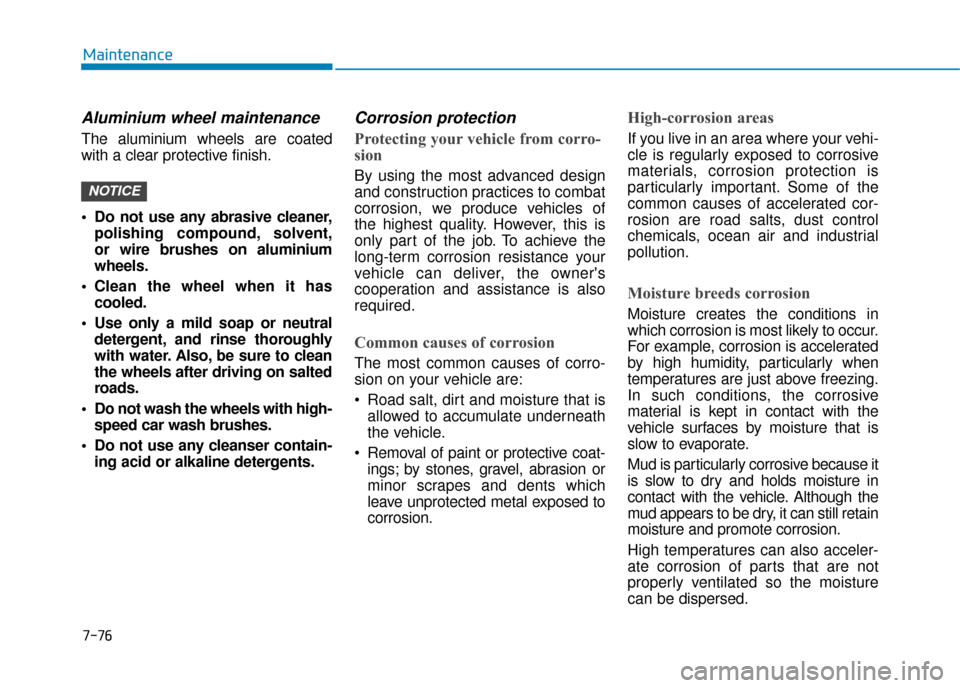
7-76
Maintenance
Aluminium wheel maintenance
The aluminium wheels are coated
with a clear protective finish.
Do not use any abrasive cleaner,polishing compound, solvent,
or wire brushes on aluminium
wheels.
Clean the wheel when it has cooled.
Use only a mild soap or neutral detergent, and rinse thoroughly
with water. Also, be sure to clean
the wheels after driving on salted
roads.
Do not wash the wheels with high- speed car wash brushes.
Do not use any cleanser contain- ing acid or alkaline detergents.
Corrosion protection
Protecting your vehicle from corro-
sion
By using the most advanced design
and construction practices to combat
corrosion, we produce vehicles of
the highest quality. However, this is
only part of the job. To achieve the
long-term corrosion resistance your
vehicle can deliver, the owner's
cooperation and assistance is also
required.
Common causes of corrosion
The most common causes of corro-
sion on your vehicle are:
Road salt, dirt and moisture that isallowed to accumulate underneath
the vehicle.
Removal of paint or protective coat- ings; by stones, gravel, abrasion or
minor scrapes and dents which
leave unprotected metal exposed to
corrosion.
High-corrosion areas
If you live in an area where your vehi-
cle is regularly exposed to corrosive
materials, corrosion protection is
particularly important. Some of the
common causes of accelerated cor-
rosion are road salts, dust control
chemicals, ocean air and industrial
pollution.
Moisture breeds corrosion
Moisture creates the conditions in
which corrosion is most likely to occur.
For example, corrosion is accelerated
by high humidity, particularly when
temperatures are just above freezing.
In such conditions, the corrosive
material is kept in contact with the
vehicle surfaces by moisture that is
slow to evaporate.
Mud is particularly corrosive because it
is slow to dry and holds moisture in
contact with the vehicle. Although the
mud appears to be dry, it can still retain
moisture and promote corrosion.
High temperatures can also acceler-
ate corrosion of parts that are not
properly ventilated so the moisture
can be dispersed.
NOTICE
Page 495 of 526

7-78
Maintenance
Interior care
Interior general precautions
Prevent chemicals such as perfume,
cosmetic oil, sun cream, hand cleaner
and air freshener from contacting the
interior parts because they may
cause damage or discolouration. If
they do contact the interior parts, wipe
them off immediately.
See the instructions that follow for
the proper way to clean vinyl.
Never allow water or other liquids to
come in contact with electrical/elec-
tronic components inside the vehi-
cle as this may damage them.
When cleaning leather products
(steering wheel, seats etc.), use
neutral detergents or low alcohol
content solutions. If you use high
alcohol content solutions or acid/
alkaline detergents, the colour of
the leather may fade or the sur-
face may get stripped off.
Cleaning the upholstery andinterior trim
Vinyl (if equipped)
Remove dust and loose dirt from
vinyl with a whisk broom or vacuum
cleaner. Clean vinyl surfaces with a
vinyl cleaner.
Fabric (if equipped)
Remove dust and loose dirt from fabric
with a whisk broom or vacuum cleaner.
Clean with a mild soap solution recom-
mended for upholstery or carpets.
Remove fresh spots immediately with
a fabric spot cleaner. If fresh spots do
not receive immediate attention, the
fabric can be stained and its colour can
be affected. Also, its fire-resistant prop-
erties can be reduced if the material is
not properly maintained.
Using anything but recommended
cleaners and procedures may affect
the fabric’s appearance and fire-
resistant properties.
Leather (if equipped)
Features of seat leather
- Leather is made from the outerskin of an animal, which goes
through a special process to be
available for use. Since it is a nat-
ural product, each part differs in
thickness or density.
Wrinkles may appear as a natural result of stretching and shrinking
depending on the temperature
and humidity.
- The seat is made of stretchable fabric to improve comfort.
- The parts contacting the body are curved and the side supporting
area is high which provides driv-
ing comfort and stability.
- Wrinkles may appear naturally from usage. It is not a fault of the
product.
NOTICE
NOTICE
NOTICE
Page 513 of 526
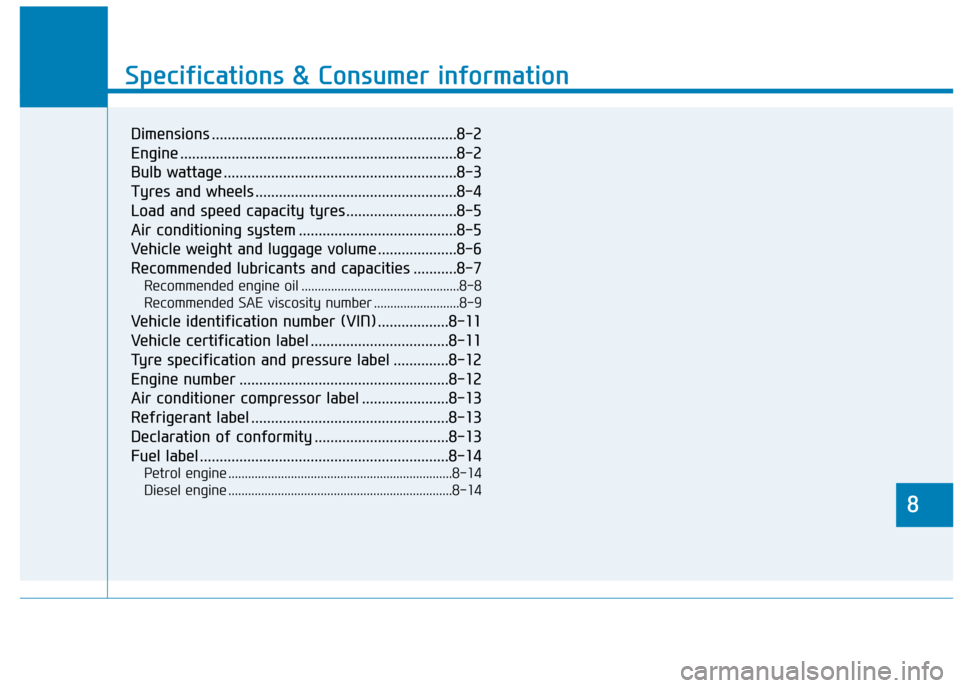
8
Specifications & Consumer information
8
Specifications & Consumer information
8
Dimensions ..............................................................8-2
Engine ......................................................................8-\
2
Bulb wattage ...........................................................8-3
Tyres and wheels ...................................................8-4
Load and speed capacity tyres ............................8-5
Air conditioning system ........................................8-5
Vehicle weight and luggage volume ....................8-6
Recommended lubricants and capacities ...........8-7
Recommended engine oil ................................................8-8
Recommended SAE viscosity number ..........................8-9
Vehicle identification number (VIN) ..................8-11
Vehicle certification label ...................................8-11
Tyre specification and pressure label ..............8-12
Engine number .....................................................8-12
Air conditioner compressor label ......................8-13
Refrigerant label ..................................................8-13
Declaration of conformity ..................................8-13
Fuel label ...............................................................8-14
Petrol engine ....................................................................8-14\
Diesel engine ....................................................................8-14\
Page 514 of 526
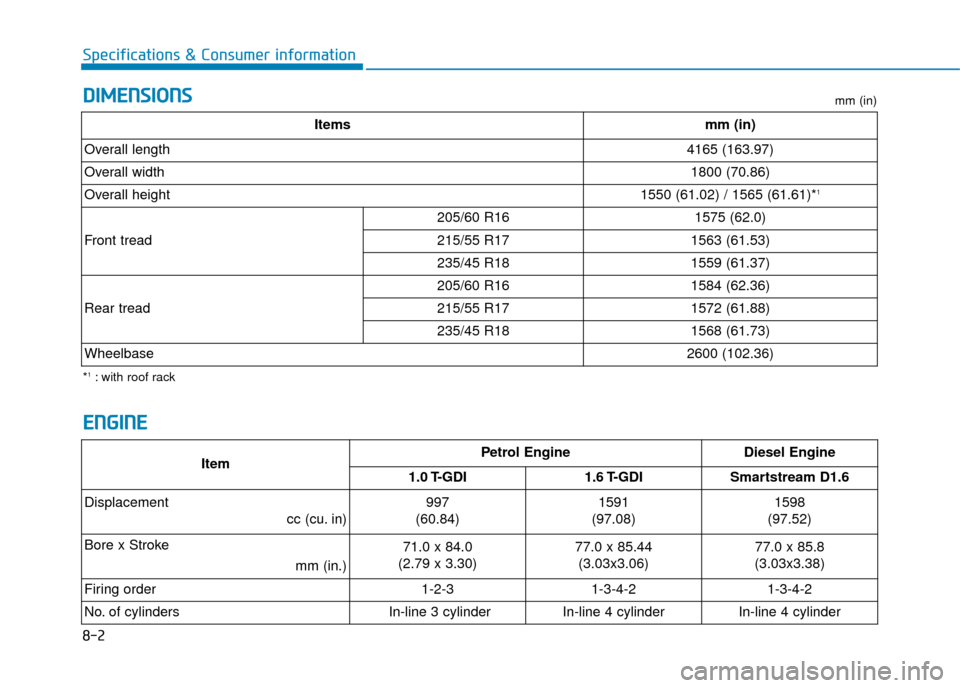
8-2
Specifications & Consumer information
D
DI
IM
M E
EN
N S
SI
IO
O N
NS
S
E
E N
N G
GI
IN
N E
E
ItemPetrol EngineDiesel Engine
1.0 T-GDI 1.6 T-GDISmartstream D1.6
Displacement cc (cu. in)
997
(60.84)1591
(97.08)1598
(97.52)
Bore x Stroke mm (in.)
71.0 x 84.0
(2.79 x 3.30)77.0 x 85.44 (3.03x3.06)77.0 x 85.8
(3.03x3.38)
Firing order
1-2-31-3-4-21-3-4-2
No. of cylinders
In-line 3 cylinderIn-line 4 cylinderIn-line 4 cylinder
*1: with roof rack mm (in)
Itemsmm (in)
Overall length4165 (163.97)
Overall width1800 (70.86)
Overall height1550 (61.02) / 1565 (61.61)*1
Front tread
205/60 R161575 (62.0)
215/55 R171563 (61.53)
235/45 R181559 (61.37)
Rear tread
205/60 R161584 (62.36)
215/55 R171572 (61.88)
235/45 R181568 (61.73)
Wheelbase2600 (102.36)
Page 516 of 526
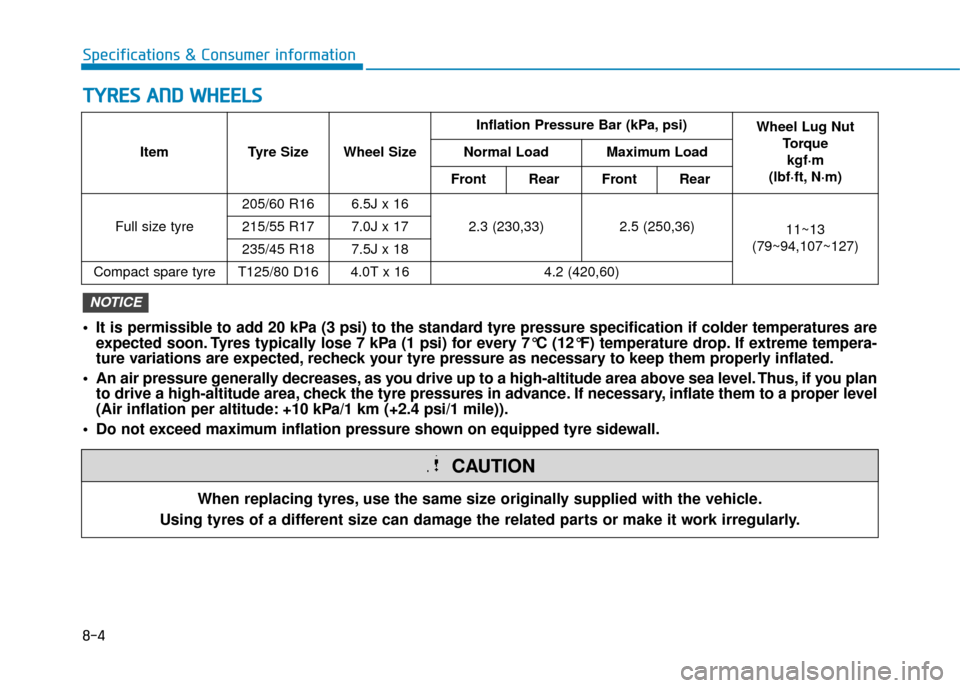
8-4
Specifications & Consumer information
ItemTyre Size Wheel Size Inflation Pressure Bar (kPa, psi)
Wheel Lug Nut
Torque kgf·m
(lbf·ft, N·m)
Normal Load Maximum Load
Front Rear Front Rear
Full size tyre 205/60 R16 6.5J x 16
2.3 (230,33)2.5 (250,36)
11~13
(79~94,107~127)
215/55 R17 7.0J x 17
235/45 R18 7.5J x 18
Compact spare tyre T125/80 D16 4.0T x 16 4.2 (420,60)
T TY
Y R
RE
ES
S
A
A N
N D
D
W
W H
HE
EE
EL
LS
S
When replacing tyres, use the same size originally supplied with the vehicle.
Using tyres of a different size can damage the related parts or make it work irregularly.
CAUTION
It is permissible to add 20 kPa (3 psi) to the standard tyre pressure specification if colder temperatures are expected soon. Tyres typically lose 7 kPa (1 psi) for every 7°C (12°F) temperature drop. If extreme tempera-
ture variations are expected, recheck your tyre pressure as necessary to keep them properly inflated.
An air pressure generally decreases, as you drive up to a high-altitude area above sea level. Thus, if you plan to drive a high-altitude area, check the tyre pressures in advance. If necessary, inflate them to a proper level
(Air inflation per altitude: +10 kPa/1 km (+2.4 psi/1 mile)).
Do not exceed maximum inflation pressure shown on equipped tyre sidewall.
NOTICE